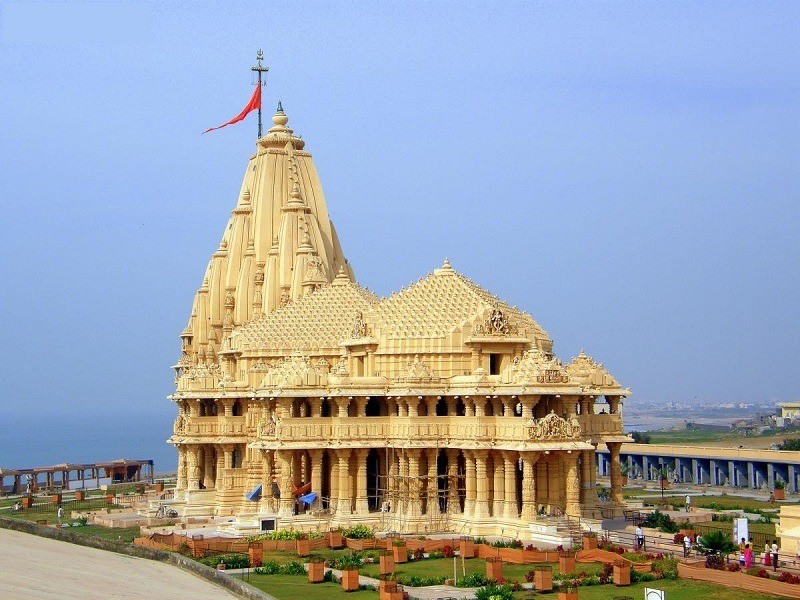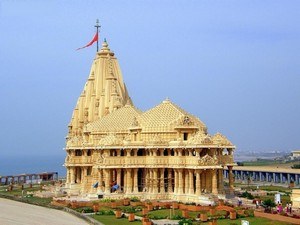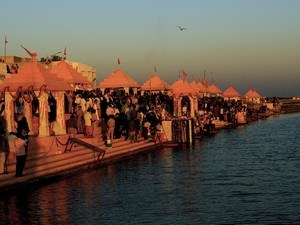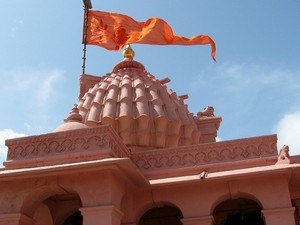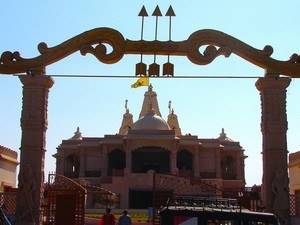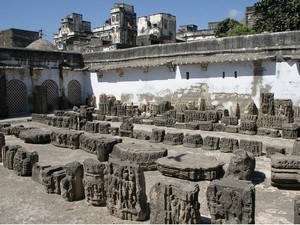Somnath Temple, Somnath - Timings, Festivals, History, Darshan, Pooja Timings
Photo Credit: Flickr
 #1 of 11 Places to Visit in Somnath
#1 of 11 Places to Visit in Somnath
 Distance (From Somnath Railway Station): 2 Kms
Distance (From Somnath Railway Station): 2 Kms
 Trip Duration (Including Travel): 2-3 Hours
Trip Duration (Including Travel): 2-3 Hours
 Transportation Options: Cab / Auto
Transportation Options: Cab / Auto
 Travel Tips: People of any race and religion can enter the temple. But no one is permitted to enter the main Sanctum Sanctorum except the Priests.
Travel Tips: People of any race and religion can enter the temple. But no one is permitted to enter the main Sanctum Sanctorum except the Priests.
About Somnath Temple
At a distance of 2 Km from Somnath Railway Station, Somnath Temple is a Hindu temple situated in Prabhas Patan on the coast of Arabian Sea in Gujarat. Dedicated to Lord Shiva, Somnath Temple is believed to be the first among the twelve jyotirlinga shrines of Shiva. Somnath means 'Lord of the Soma', an epithet of Shiva. According to history scholars, the site of Somnath has been a pilgrimage site from ancient times as it was said to be the confluence point of three rivers, Kapila, Hiran, and the mythical Saraswati. The confluence was called Triveni Sangam and is believed to be the place where Soma, the Moon-god bathed and regained his luster. It is one of the most important pilgrimage sites in Gujarat for Hindus and among the must include places in Somnath tour.
History of Somnath Temple
According to Puranas, the original temple of Somnath was built in gold by the moon god Soma, in silver by the sun god Ravi, in wood by Lord Krishna, and in stone by the Solanki Rajputs in the 11th century. According to history, The temple had been destroyed as many as 6 times by Muslim rulers- Junamad in 722 CE, Mahmud of Ghazni in 1024 CE, Allaudin Khilji in 1299 CE, Mohammed Begeda in 1451, Portuguese in 1546, and finally by Aurangzeb in 1702, which was the worst of all attacks when a great wealth was stolen and a large number of people were killed. The temple was rebuilt every time with the reconstructive spirit of the people. The modern temple was reconstructed with the resolve of Sardar Vallabhbai Patel who visited the ruins of Somnath Temple in 1947 and then President of India, Dr. Rajendra Prasad, installed the Jyotirlinga in the present temple in 1951.
Mythology of Somnath Temple
The legend of Somnath Temple centers on Chandra, the Moon God. As per the narrative, Chandra was wed to the 27 daughters of Daksha Prajapati, yet he held a special affection for Rohini, which caused distress among his other wives and their father. In response, Daksha cursed Chandra to wane, causing the moon to lose its brightness. Chandra, now weakened and diminished, traveled to the holy site of Prabhasa, where he prayed to Lord Shiva. He bathed in the Saraswati River and offered worship to the Sparsa Linga of Somnath. Moved by Chandra's sincere devotion, Lord Shiva granted him a blessing, restoring his luminosity. In appreciation, Chandra constructed the Somnath temple, crafted from gold, as a tribute to Shiva.
Architecture of Somnath Temple
Regarded as one of the best places to visit in Dwarka, the current temple of Somnath, known as Kailash Mahameru Prasad, has been reconstructed in the Chalukya architectural style. The temple's main spire, or sikhara, reaches a height of 15 meters, topped by an 8-meter flagpole. This architectural design showcases the craftsmanship of the Sompura Salats, esteemed masons from Gujarat. Perched on the Saurashtra peninsula, the temple offers a stunning view, surrounded by the Arabian Sea. Its remarkable structure features detailed carvings, silver doors, a magnificent Nandi idol, and a central Shiva linga. Additionally, a Banastambha located on the temple's sea protection wall indicates that there is no land in a direct line from the Somnath seashore to Antarctica. Visitors can also explore Shri Kapardi Vinayak, Shri Hanuman Temple, and Vallabhghat.
Each evening, the temple is beautifully illuminated, and the 'Jay Somnath' Sound & Light Show is presented nightly, providing pilgrims with a transcendent experience against the backdrop of the majestic Somnath temple and the soothing sounds of the ocean.
Festivals of Somnath Temple
The Somnath Temple in Gujarat hosts a variety of festivals, such as Maha Shivratri, Kartik Purnima, and Navratri. Maha Shivratri, a prominent festival, is observed with unique pujas and rituals during February/March. Kartik Purnima, which takes place in November/December, features a five-day public fair known as Dev Diwali. This evening is particularly significant due to the prayers and deepdaan (floating lamps), where thousands of oil lamps are illuminated and set afloat in the water, symbolizing the dispelling of darkness and the triumph of light. Navratri and Dussehra are also important, marked by special ceremonies and celebrations.
Somnath Temple Dress Code & Other Restrictions
When planning a visit to the Somnath Temple in Somnath, it is advisable to wear modest attire that covers the upper arms and legs as a mark of respect. Men should consider donning a dhoti or pajama with an upper garment, or alternatively, formal trousers and shirts. Women may choose to wear a saree, half saree, or chudidhars. It is recommended to avoid modern clothing such as mini-skirts, jeans, shorts, and sleeveless tops while on the temple premises.
Non-Hindus are required to obtain permission from the office of the general manager of the Shree Somnath Trust prior to entering the Somnath Temple for darshan, a requirement that applies to all non-Hindu visitors.
Somnath Temple Timings
Monday: 6 AM - 9:30 PM & Sound & Light Show: 8 PM - 9 PM
Tuesday: 6 AM - 9:30 PM & Sound & Light Show: 8 PM - 9 PM
Wednesday: 6 AM - 9:30 PM & Sound & Light Show: 8 PM - 9 PM
Thursday: 6 AM - 9:30 PM & Sound & Light Show: 8 PM - 9 PM
Friday: 6 AM - 9:30 PM & Sound & Light Show: 8 PM - 9 PM
Saturday: 6 AM - 9:30 PM & Sound & Light Show: 8 PM - 9 PM
Sunday: 6 AM - 9:30 PM & Sound & Light Show: 8 PM - 9 PM
Somnath Temple Entry Fee
General Entry is Free
VIP Darshan available for Rs. 500
Sound & Light Show available for Rs. 25
Best Time to Visit Somnath Temple
The best time to visit Somnath Temple is during the winter months, specifically from October to February, when the climate is cool and enjoyable, making it perfect for both sightseeing and pilgrimage. Significant events such as Maha Shivratri in February/March and Kartik Purnima in November provide an exceptional chance to experience the vibrant atmosphere of the temple, attracting numerous devotees. Conversely, the summer months from April to June can be quite severe due to elevated temperatures, while the monsoon season from July to September is characterized by heavy rainfall and strong winds, which may not be conducive for travel.
How to Reach Somnath Temple
Diu Airport is the nearest airport which is about 80 Km from Somnath and is well connected by flights with Mumbai. Somnath Railway Station has regular trains from Ahmedabad, Rajkot, Jabalpur, Okha, and Porbandar. About 7 Km, Veraval Junction Railway station is the nearest major railhead, which has trains from Mumbai, Ahmedabad, Pune, Indore, and Trivandrum. Somnath Bus Stand is directly connected by bus with cities like Rajkot, Ahmedabad, Diu, Jamnagar, Porbandar, Bhavnagar, Gandhidham, Bhuj, Vadodara, Junagadh, Udaipur, and Surat. From these places, one can reach Somnath Temple by hiring as auto-rickshaw, or cab.



